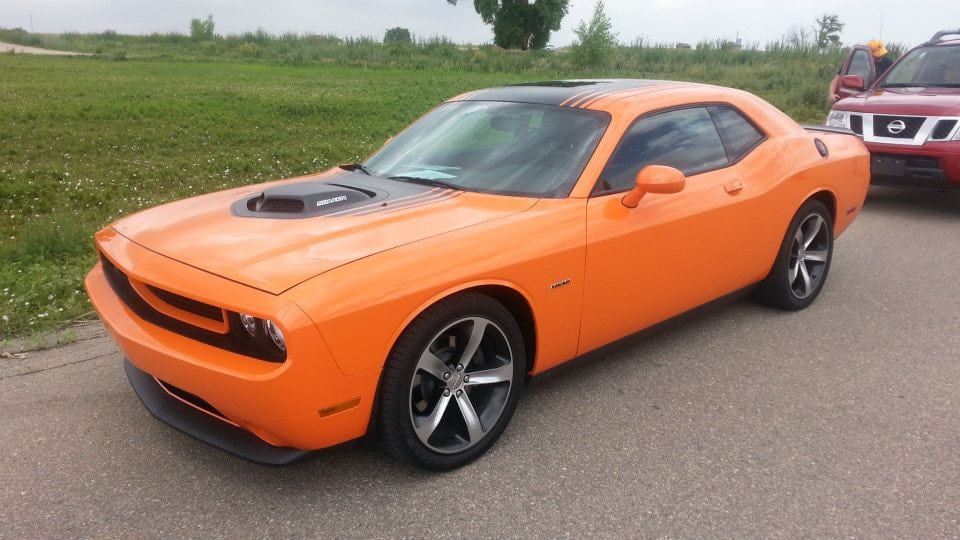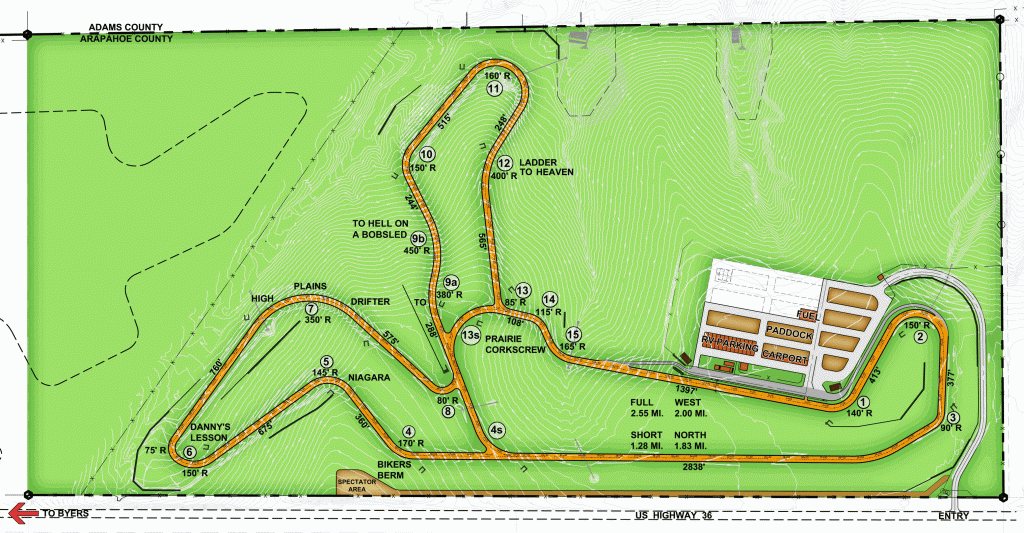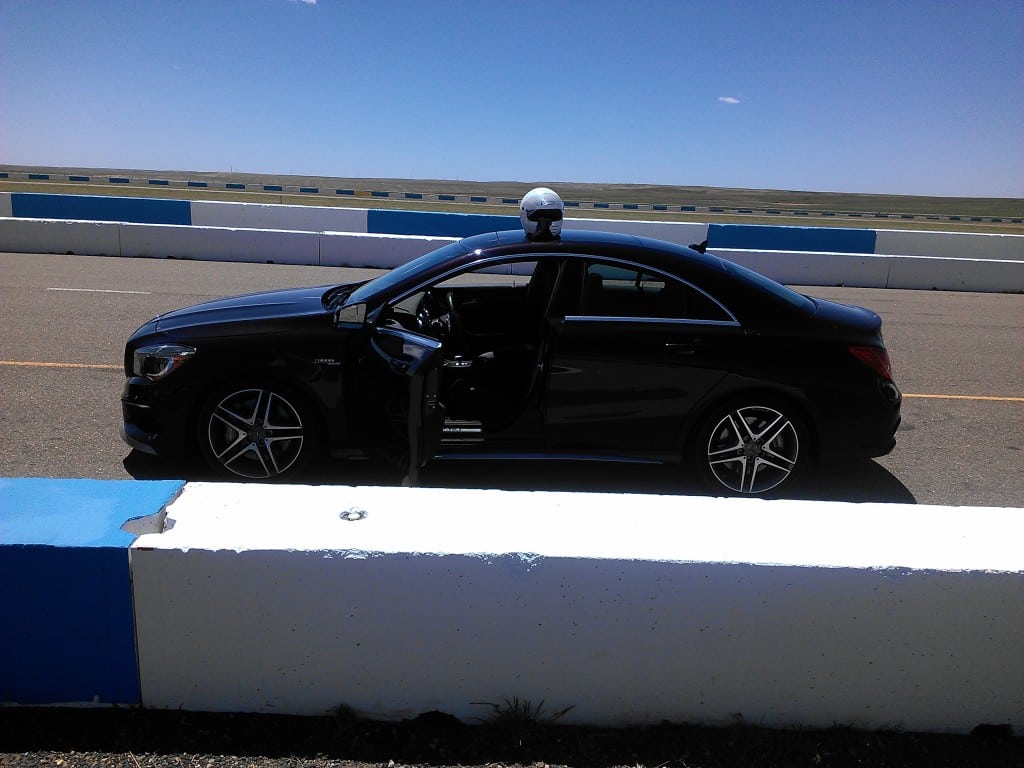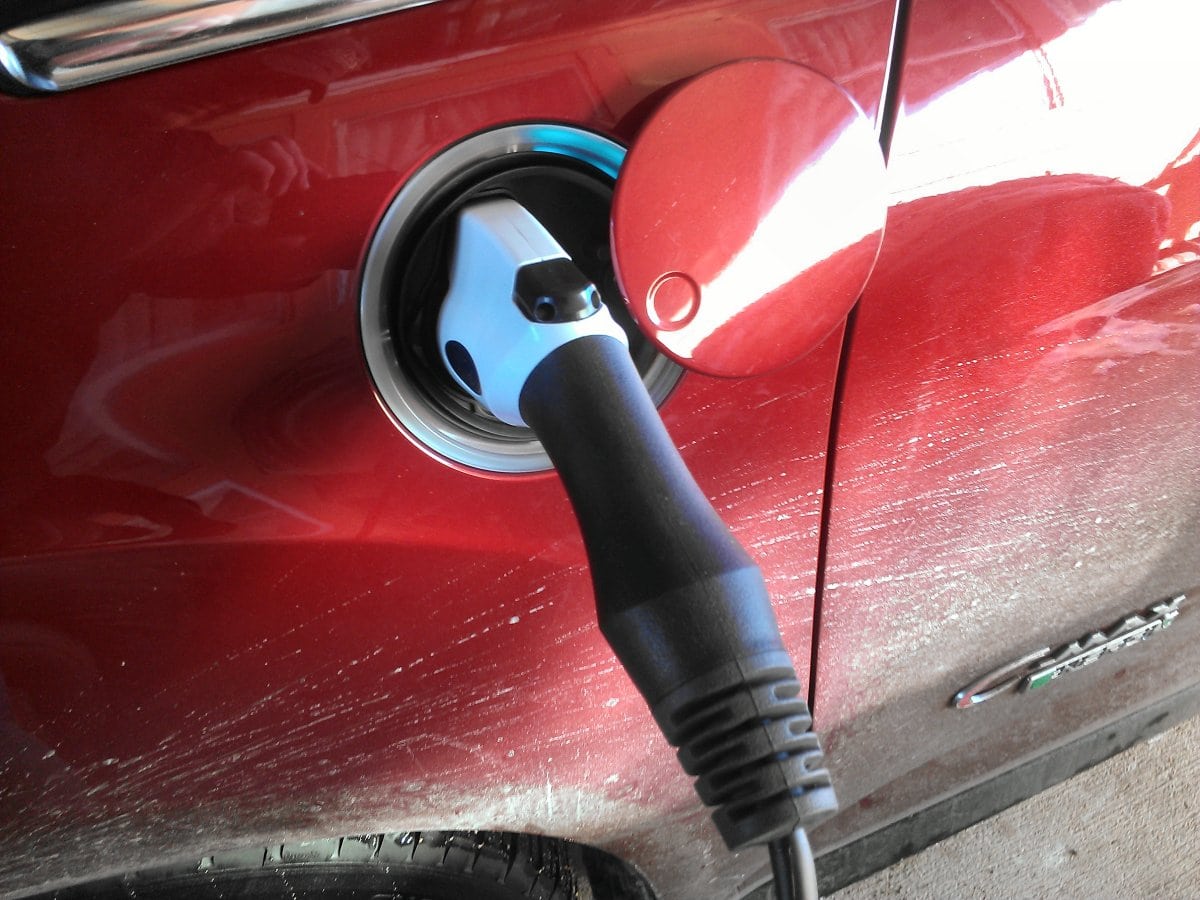Thursday, a group of journalists from the Rocky Mountain Automotive Press (RMAP), including myself, converged for the second day of the Rocky Mountain Driving Experience 2014 (RMDE). This day is the one many of us look forward to the most, as it’s track day – the day we take vehicles manufacturers have generously provided for us to drive like madmen and women around the High Plains Raceway (HPR).
The track itself is a beautiful place out in the middle of the country east of the Denver International Airport. The surrounds include a small highway, corn fields, cattle grazing nearby, and a lovely vista of rolling hills and low-growth greenery typical of the High Plains.
The HPR track has curves of various degrees, strong straightaways, and elevation changes that create a challenge for most drivers and a competition-level difficulty for professionals. We being amateurs and the interest of safety and fun being the most important for our event, though, meant that we used only about a third of the track in what’s called the “short loop.” This doesn’t mean it’s easy. At least, not for those of us who are pure amateurs on the track. For myself, this was my third year at RMDE.
The “short loop” consists of seven turns ranging from simple S-curves to hard ninety-degree bends. The pits enter the track between curves 2 and 3, sending the driver into the gentle third curve which becomes the long straight. As you can see from the track map above, that breaks into turn 4s to a short straight and into 13s, a long ninety-degree turn that actually feels like two turns when you’re in it before dumping you out into a relatively easy S-curve and another short straightaway. That ends at a near-ninety hard left (curve 1) and then a right (curve 2) in a U-turn. For me, curve one is always the toughest as coming out of the S and into the straight, you cannot see the curve until you’ve climbed the slope past the control tower and are nearly on the warning sticks announcing the turn. If you mis-calculate the first curve, you’ll almost certainly be either going very slow into the second or fighting to keep control getting through it. For me, this is the most difficult place on the track to “hold the lane” (the sweet spot for maximizing speed and minimizing stress on a race track).
On this day on the track, we had several great cars to choose from, doing three laps on each run before returning to the pits to cool off and grab the next drive. With 20 or so journalists and almost as many factory representatives to give us the low-down on the vehicles we’d be driving, as well as a handful of amateur and professional drivers with years of experience on this particular track, questions were quickly answered and demonstrations and how-to instruction was easy to find.
We opened with a slow familiarization lap to get the lay of the land and have an expert show us the lane at relatively slow speeds. After that, the track went “hot” and we began our triple laps in cars of our choosing. During the day, I managed to drive every car available for track use and had a great time doing it. More than one car was driven two or three times, including a second warmup lap after lunch and a final “victory lap” before we left.
2014 Cadillac XTS Vsport
Not surprisingly, for those who’ve followed Cadillac lately, this car is a wonder on the track. My first time in this car for the day was riding with a friend who is a better driver than I (on the track, at least). This turbocharged luxury sports sedan throws out 410 horses from its 3.6-liter V6. Although similar in size and displacement to the standard, naturally-aspirated V6 in the XTS, this Vsport tuned engine is very different. On the track, it’s responsive and far higher-powered than expected. Its six-speed automatic transmission is also very sport-tuned and handles itself well without driver input. Power drops quickly at the redline (5,600 RPM), but unless you try to manually override (which it will ignore if it’s going into the red), the transmission is more than capable of keeping you going without your help. On my own hot lap in the XTS Vsport, I found it a pavement-hugging, curve-loving monster with a lot of finesse. Easily comparable to the Lexus IS350 F-Sport that was also present.

Photo courtesy of Rob Endter at ColoradoCarShow.com
2014 Dodge Challenger R/T Shaker
The big, orange beast that everyone looked forward to was the 2014 Dodge Challenger Shaker. This powerhouse of muscle was the only true American muscle car on the track for us to drive. I had driven it on the road the day before during our mountain driving portion of the event and so (luckily) had learned the transmission (six-speed manual), which takes a little getting used to due in large part to the engine’s need to be at what foreign car drivers would consider high RPM for everyday driving. Once this is down, though, the Challenger is a beautiful ride on the road. On the track, it’s a blast. The best muscle car ever? Nobody is going to agree on that. The most fun I had all day? Hell yes.
To start with, the Challenger comes in one of my favorite colors: a subtle bright orange. Second, it has a beautiful retro Challenger look that I happen to like a lot. It’s also far less intimidating for an amateur racer than expected, with the smaller 5.7-liter V8 outputting 375 horsepower. Like most American muscle cars, it does not sprint around the curves like a Mazda or Fiesta might, but it glides around them well if you use gearing and the advantage of rear-wheel drive to make it happen. On my first hot lap around the track in this car, I did pretty well since I was already familiar with its sweet spot for RPM and torque (roughly 4,800 RPM). From there, it was just a matter of holding the power band and learning to take the curves, which came naturally once any lingering intimidation over the car had vanished. By my third lap, I was loving this car. When the next guy up to drive this car failed to come around and no one asked to take his place, I got back in and did three more laps.
Dreamy. I was so happy when I pulled into the pits again after my sixth run around, I was beaming with pride at having done my only perfect lap for the day. I jumped from the car and ran up to our Chrysler representative, Wendy Orthman, and grabbed her in a big bear hug. “That was so AWESOME!”
2014 Ford Fiesta ST
For its part, Ford brought us a fun little Fiesta ST. Last year, we had the Focus ST, which I enjoyed, but had trouble driving because the seats were too compact for my large frame. The Fiesta ST had no such troubles and even contained headroom for me with a helmet on. Quite a feat for such a small car.
This compact outputs 197 horsepower and 202 lb-ft of torque to the front wheels. The torque is all at the low end and the horses all at the top with a decent powerband between. With a six-speed manual through which that tiny 1.6-liter powerhouse is pumping, though, the car becomes infinitely controllable on the track. It may not sprint fast, but it does something most Ford cars don’t: it corners tightly. That gives it an edge, though the front-wheel drive understeer does create some work for the driver to learn to overcome. All in all, a good showing for a $22,000 (or so) mini-racer from Ford.
2014 Infiniti Q50
This is another car that I drove both on the road the day before and on the track on this day. On the road, it’s a luxurious ride and a well-appointed, nicely-balanced luxury machine. As is expected from Infiniti. On the track, it’s a true learning experience that adds fun and excitement to what would otherwise likely have been a boring “luxury V6 around the race track.” (If you can call that boring.)
The learning experience comes from the new fly-by-wire steering this car features. Every nuance and gesture you give the steering wheel translates instantaneously to the wheels. Until you’ve felt it yourself, you probably won’t understand how this disrupts your driving habits. We’re used to slop and delay time in turning the wheel and tires heaving around to match. There’s none of that in the Q50. This made it a lot of fun because on the first lap, I instinctively turned and expected the wheels to take a moment to follow and ended up fishtailing on the S-curves as a result. By the third lap, I was loving the ability to precisely control the turns and curves and relishing the powerful growl of Infiniti’s beautiful six. Later in the day, I took another three laps in this car and really enjoyed the mix of precision and control it offers.
2014 Kia K900
This much-talked-about luxury car from Kia was a real stunner. Until you’ve seen it in person, don’t underestimate what the Koreans can do with luxury. Although I did not get a chance to drive it on the road (one of the few I missed), I should have a full review soon as I’m expecting this as a press loan this summer. In the mean time, on the track, I had only three laps in the car, but enjoyed its feel. It’s not truly a track car, but it handled well for a “normal” vehicle hitting the curves.
2014 Lexus IS350 F-Sport
This car, of course, should already be familiar to CarNewsCafe readers as we did a full review of it earlier this month (read that here). It’s a lovely and well-refined luxury sports sedan. On the track, it’s a very good contender for the Cadillac as well. It has more body roll than the Caddy, but makes up for that with all-wheel drive and better get-up out of the curve. This car’s power and handling in Sport Plus mode is astounding for such a posh street machine. Although I only managed a three-loop run in this car for the day, I enjoyed every minute of it and my familiarity with its performance helped make this car become one of my best track experiences of the day.
2014 Mercedes-Benz CLA45 AMG
This was the car I drove in the warm-up lap at the beginning of the afternoon’s driving. I then drove it in hot laps as well, giving me a total of six loops around the track in this amazing little car. It features a small, 2.0-liter, four-cylinder engine that produces a whopping 355 horsepower. This runs through a seven-speed dual-clutch transmission. I tried it in both manual and automatic modes and found that the trans was well-tuned and did well on its own without my input shifting when in Sport mode.
This little Merc handles well, corners nicely, and is very comfortable despite my having to wear a helmet and have the window down at all times. My chief complaint was lack of power in comparison to some other cars on the track, particularly in the lower end when coming out of curves. I suspect that given more time learning to control it in manual mode, this can be compensated for by controlling RPM. A professional racer I spoke with after he’d driven the car agreed with that and said he was doing well holding speeds by keeping the power band high, manually.
2014 Mazda3
This is another vehicle readers might remember from my full review last month (read that here). I was excited to see it on the track and couldn’t wait to give it a try as I’d thoroughly enjoyed its sportiness on the road. I was not disappointed as this car does very well. Although the 2.5-liter is a little slow on the uptake, I eventually learned how to control the powerband in this car to maximize its performance through the curves and into the straights. It didn’t take much as the SKYACTIV chassis and tuning are a sports car driver’s dream.
The Mazda3 is a good example of a capable family car with good ergonomics that happens to be a fun weekend track car for the occasional racer.
2014 Nissan Altima
Definitely not a track car, but the Altima has much going for it regardless. I did a full review of the last year’s model (read that here) and found a few nuances to be different this year. I think the greatest change is in the suspension, which is softer now. Not as good for the track, but on the road, this would dampen some of the complains anyone not expecting a sporty feel from their sedan might have noticed. Personally, I would have preferred that it stay stiff as I felt that the Zero Gravity seats made up for any jarring that slightly stiffer suspension might have made.
2014 Nissan Juke NISMO
Those of you who listen to our podcast know that I’m a huge fan of the Juke. Ever since my week-long drive in the Juke NISMO last year (read it here), I’ve loved this little crossover. Although I still believe it’s a dirt rally madhouse, on the track, it was lackluster when I drove it at last year’s RMDE. This year, though, we had the new 2014 with a six-speed manual transmission (versus the CVT of last year). That made all the difference.
I managed two circuits (six laps) in the Juke NISMO this time. For 2014, the suspension has been slightly re-tuned for stiffness and, as mentioned, the manual transmission made it a very different drive on the track. As expected, the Juke is nimble, responds quickly to curves thanks to its short wheelbase, and powers out of the corners well if properly shifted. Gearing ratios are very good for amateur track buffs, by the way.
2014 Range Rover Sport
Our experience in the Range Rover Sport was only with a factory driver. Given the price tag and cost of replacement should it wreck, though, I don’t blame Rover for being stingy about who gets behind the wheel. Even at that, it was a fun ride and handles much better than expected for an SUV.
2015 Volkswagen GTI
This was the surprise entry this year that no one expected to show and everyone expected to be fun. It did show and it was fun. I first saw this VW at the auto show earlier this year and was intrigued at Volkswagen’s total re-build of it’s most popular global platform. I drove the TDI version of the Golf on the road the day before and could see that everything had been improved in a big way with that car. This being my first experience in a GTI, let alone on the track, I asked a friend who’s very familiar with Volkswagen Group products to take me out and show me the ropes for this car. She obliged and it turned out to be a fast learning experience.
This is an exceedingly lightweight car, weighing in at just over 3,000 pounds, with a roomy interior (given its size and hatchback shape). The 2.0-liter turbo spits out 210 horsepower and 207 lb-ft of torque. Like the Juke mentioned earlier, this car dreams around the corners thanks to its low stance, small wheelbase, and heavy front-end. Understeer is nicely controlled thanks to German engineering across the front end and in my own hot laps in this car, I had a great time flipping at hard angles to achieve the corners. You have to hand it to those Germans, they know how to make a fun-to-drive car.
Coming Soon
Off the track, we also drove many other vehicles, which we’ll detail in short, road-based first-impression reviews in the coming weeks here on CarNewsCafe.
If you’ve never driven on a race track before, I highly recommend it. There are amateur and pro-am racetracks around the country in just about every place imaginable. Rental time to get on the track (or open track days) are not too expensive and even the most mundane car can become a fun drive on a race track. In addition, racing schools often have first-timer classes and provide vehicles for the track. It will be a day you’ll not soon forget.









